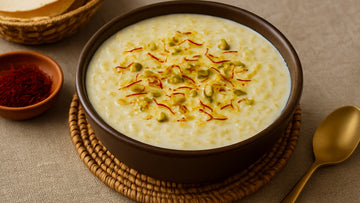Kesar Kheer is one of the oldest and most comforting Indian desserts. It is also known as saffron rice pudding. If you’re fond of Kesar Sweets, then Kesar Kheer is something you must taste. Made with rice, full-fat milk, saffron strands, and aromatic cardamom, it offers both indulgence and nourishment.
In homes across India, Kesar Kheer is served at festivals, family gatherings, quiet evenings, whatnot! If you're looking for a traditional dessert with health appeal and clean ingredients, the kesar kheer recipe delivers.
What Is Kesar Kheer?
Kesar kheer is a slow-cooked pudding made by simmering rice in milk until it turns creamy, then adding saffron-infused milk, sugar, and dry fruits. Saffron is what gives it that rich golden hue and a floral aroma.
While there are modern shortcuts, the best version of saffron kheer recipe relies on patience: letting the milk thicken naturally and stirring constantly to bring out its full flavor.
Why Kesar Kheer Appeals to Health-Conscious Eaters
Wholesome Ingredients: It’s made with milk, rice, saffron, and nuts—no additives, preservatives, or artificial sweeteners (unless you choose).
Saffron’s Natural Appeal: Known for its antioxidants and soothing properties.
No Refined Junk: Sweetened naturally with sugar or jaggery, and customizable for calorie-conscious choices.
Vegetarian: Completely egg-free and suitable for lacto-vegetarian diets.
For those seeking to incorporate more functional foods into their diet, saffron brings more than just flavor. There are many saffron benefits for skin, including anti-inflammatory and antioxidant effects, when consumed regularly.
Ingredients for Kesar Kheer (Serves 4-6)
|
Ingredient |
Quantity |
|
Full-cream milk |
2 liters |
|
Basmati rice (pre-soaked 30 mins) |
½ cup |
|
Saffron strands |
½ tsp |
|
Sugar |
½ cup (adjust to taste) |
|
Cardamom powder |
1 tsp |
|
Rose water |
2 tbsp |
|
Raisins |
2 tbsp (soaked) |
|
Chopped almonds |
2 tbsp |
|
Chopped pistachios |
2 tbsp |
|
Chopped cashews |
2 tbsp |
|
Dried rose petals (optional) |
2 tbsp |
Step-by-Step Instructions
1. Soak and Prep
- Wash rice thoroughly and soak it for 30 to 60 minutes. This softens the grains and shortens the cooking time.
- Soak saffron strands in 1 table spoon of warm milk and set aside.
2. Boil the Milk
-
Use a heavy-bottomed pan. Bring 2 liters of milk to a boil. Then, reduce the heat and let it simmer. Stir occasionally to prevent sticking.
3. Add Saffron and Rice
- Add the saffron milk and pre-soaked rice to the boiling milk.
- Cook on medium-low heat. Stir frequently to avoid lumps or burning.
4. Cook Slowly
- Let the milk reduce and thicken. It can take up to 40–45 minutes.
5. Add Sweetness and Flavour
- Once the rice is soft and the milk has thickened, add sugar. Let it dissolve over low heat.
- Mix in cardamom powder and continue cooking for another 6–8 minutes.
6. Add Nuts and Final Touches
- Add raisins, pistachios, almonds, cashews, and rose water.
- Cook for 2–3 minutes and turn off the heat.
7. Serve
- Garnish with dried rose petals and a few chopped nuts.
- Serve warm or chilled.
Pro Tips for Creamy Kheer
Don’t rush: Slow cooking brings out the best texture and flavor.
Stir often: Prevents sticking and helps even cooking.
Use full-fat milk: For the best richness and creaminess.
Customize the sweetness: Use jaggery for a healthier twist.
Variations to Try
|
Variation |
How to Make It |
|
Low-Calorie Kheer |
Use toned milk and jaggery instead of sugar. Reduce nuts. |
|
Vegan Version |
Swap dairy milk with almond or coconut milk. Use maple syrup. |
|
Dry Fruit Boost |
Add figs, dates, or apricots for extra richness and fiber. |
|
No Sugar |
Use stevia or skip entirely for a naturally mild flavor. |
Storage Instructions
- Refrigerator: Store in an airtight container for up to 3 days.
- Reheating: Gently warm on the stove or in a microwave. You can add a splash of milk if it thickens too much.
Why Saffron Is the Highlight of This Dish
Saffron’s aroma, taste, and color are hard to replicate. Each strand is hand-harvested, which explains why saffron is expensive. But even a small pinch goes a long way. For those who value quality ingredients in their diet, saffron is a premium yet powerful spice worth including.
It’s also the main element that connects kesar kheer to traditional kesar sweets served during celebrations like Diwali, Eid, and weddings.
Final Words
A bowl of well-made kesar kheer is a tradition passed down through generations. It satisfies your sweet cravings without compromising on nutrition or ingredients. For health-conscious individuals, the dish combines clean cooking methods, powerful spices and wholesome textures.
So, next time you want a dessert that’s as nourishing as it is flavorful, turn to the classic kesar or Saffron kheer recipe. Cook slowly and enjoy every creamy spoonful.
Suggested - Check Kesar Doodh Recipe










